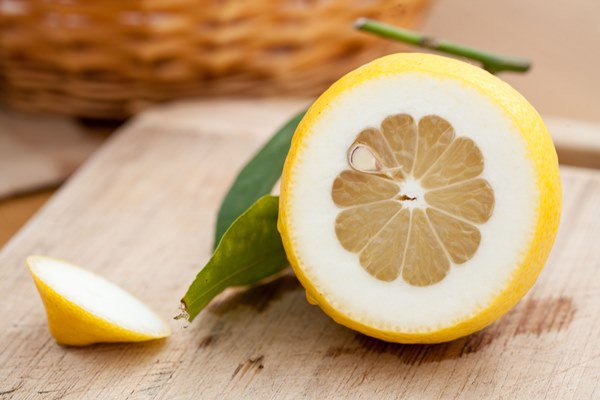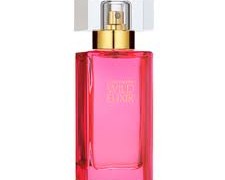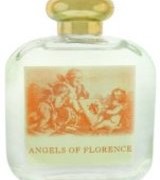According to the Greek mythology, the garden of Hesperides was a garden belonging to Zeus’s consort, Hera, where immortality-giving apples grew, tended by the daughters of Hesperus or the God of Evening, the Hesperides. Alluding to the magical golden apples, the name Hesperide came to be applied first to oranges and then to the entire citrus family.

Although citruses seem ubiquitous now, the fragrant fruit was among the precious cargo from the Spice Route. The earliest mention of citruses occurs in the Nan-Fang Ts’ao Mu (Trees and Plants of the South) written around 300 A.D. by Chi Han, while in 1178, there appears a whole chronicle dedicated to citruses, the Citrus Chronicle (Chű Lu), written by Han Yen-chih (Morris 48). Native to China and Southeast Asia, where about 500 species can be found, citruses were brought to the west by the Arabs. The parts of Europe under Arab control, such as Spain and Sicily have a long tradition of citrus cultivation. Indeed, Sicilian citrus oils have always been among the most prized. In the 14th century, spice trade was the source of revenue for Italy, specifically Venice, which after the battle at Chioggia in 1380, defeated Genoa and monopolized the trade (Morris 141). The Venetian galleys intercepted the caravans at Aleppo or Alexandria, and then would transport their wares to various guilds in Europe (141).
Since their discovery, citrus oils became an important element of European fragrances. Indeed, their popularity and usage in some ways parallels the rise of perfumery. The guild of glove and perfume-makers was established in France in the 17th century, although the first perfumer guild was established in 1190. Louis XIV (1638-1715) ordered his court perfumer M. Martial to compose a new fragrance every day, while his gardeners planted orange trees in a large orangerie (155). Colognes often included citrus oils in a highly rectified grape spirits base and were intended to be potable in addition to possessing external uses. Therefore, the famous Gone with the Wind scene, when Scarlett O’Hara gargles with cologne to mask the odor of brandy would not have been that shocking up until late 19th –early 20th century when denaturated alcohol gradually began to supplant grape spirits as perfume base.
However, it was in the 18th century when perfumery truly blossomed in Europe. The rise of eau de cologne cannot be envisioned without pleasantly warm and shimmering scent of bergamot. The court of Louis XV was known as “la cour parfumée”, “the perfumed court.” The most influential scent of the period was Aqua Admirabilis, composed by Gian Paolo Feminis in 1709. It was based on grape spirits, oils of neroli, bergamot, lavender and rosemary. Feminis moved from his native Italy to Cologne, where his nephew Jean Marie Farina continued the production of light and refreshing fragrance water, which quickly acquired the name of Eau de Cologne, based on its place of origin.
Low molecular weight means that citrus oils function remarkably well as top notes, giving lift and sparkle to just about any blend. Masculine fragrances especially are difficult to imagine without referencing citrus. An important fragrance family, chypre, always contains fresh cool notes of citrus, paired with the dark earthy notes of vetiver, oakmoss, iris, amber and patchouli.
Citrus oils are a result of cold-pressing, apart from lime and yuzu, which lend themselves better to steam distillation. Oils are deposited in glands in the fruit peel. If you are planning to use citrus oils for aromatherapeutic or perfumery purposes, I would highly recommend using organic oils, due to the fact that most of the pesticides are absorbed by the peel.
From Bergamot to Yuzu
There is an incredible variety of citruses used in fragrance, with the new varieties constantly developed, and a comprehensive review is practically impossible. However, I will attempt to overview the main citrus notes used in perfumery. Bergamot (citrus bergamia) is one of the most popular citrus notes, due to the fact that it is used extensively in a variety of fragrances, from classical eaux de cologne to modern aldehydic perfumes. Bergamot grows almost exclusively on the coast of Calabria, where it has traditionally been expressed to derive must prized oil. In 18th century, little papier-mâché boxes scented with the bergamot were very popular. Bergamot was a chief component of Napoleon’s favorite soap, Brown Windsor, which also contained clove and lavender oils. His favorite scent was bergamot, rosemary and lavender based Jean-Marie Farina’s Eau de Cologne, which the emperor consumed by liters. Before retiring, Farina sold the formula to Léonce Collas, who in turn sold the original formula to Armand Roger and Charles Gallet in 1862, who started selling Eau de Cologne in 1884, which remains in production till this day.
Grapefruit (citrus x paradisi) has a bright, crisp scent that is particularly well suited for pairings with bergamot, however it is more frequently employed in its synthetic form, as it breaks down on the skin to form malodorous compounds.
Lemon (citrus limonia) with its sunny shimmering fragrance is an epitome of summer. Native to Southern China, it is now grown in Sicily, California, Guinea, Brazil, and Israel. It is an important ingredient of colognes and many cleansing products, which is why many lemon focused fragrances immediately bring forth comparisons to Pledge.
Lime (citrus aurantiifolia) is native to India and Southeast Asia. Its scent is drier, lighter and sweeter than that of lemon, with which it blends wonderfully. Like certain notes, lime adds an instant clarity to many compositions, reinforcing the brilliant sparkle of the top notes.
Bitter orange (citrus aurantium), also known as Seville orange was one of the first citruses brought to the Mediterranean from China (Morris 109). Some of the most important uses of bitter orange is a distillation of flowers for production of either orange blossom absolute (solvent extracted) or neroli (if steam distilled). Its immature buds and leaves can also be distilled to form petitgrain bigarade, a wonderful oil that has a verdant accent against the backdrop of floral and citrusy tapestry. Sweet Valencia type orange (citrus sinensis), on another hand, produces a sweet, fruity oil that is frequently used for isolation of limonene and other derivatives. In fragrance, it can add a sweet radiant quality, especially when blended with white florals. Some of my favorite orange combinations are with neroli, which seem to produce the most interesting result—innocence of orange blossom with a fruity radiance of sweet orange peel.
Clementine, mandarin, tangerine and kumquat come from different species of citruses and have different olfactory characteristics. Of these, mandarin is one of the most frequently used in perfumery for its mild, sweet, but unusually complex scent. It seems to accent leather accords particularly well, adding a glowing quality, even if the actual note is blended well. Like mandarin, clementine (Citrus clementine) is used for peel (oil of clementine) and the leaves steam-distillation (clementine petitgrain), which is the sweetest and gentlest petitgrain out of all I have sampled.
Finally, my personal favorite citrus note is yuzu (Citrus junos), which is solvent extracted from the peel of a Japanese fruit. The tart, dry aroma reminiscent of green grapefruit has a very uplifting quality. Moreover, the tart yuzu note can add longevity to other more volatile citrus blends, persisting well into the heart of the composition.
However, while citrus notes are commonly used for the top notes and their sparkling feel, other plants can be incorporated to much the same effect. Litsea cubeba, by way of example, contains about 75% of citral, which gives it a lemony scent, high valued for prolonging more fleeting citrus notes. Lemon myrtle (Leptospermum citratum, or Lemon tea tree) is native to Australia and New Zealand contains about 90-95% citral, and is indeed more lemony than lemon itself.
Perfume containing citrus notes (the length of this hardly a comprehensive list points to the importance of citrus notes in perfumery. Please add your favorites!):
Bergamot: The Different Company Divine Bergamot, Christian Dior Miss Dior, Parfums de Nicolaï Cologne Sologne (also contains lime and lemon), Guerlain Eaux (Eau de Coq, Eau Impériale, Guerlain Eau De Fleurs De Cedrat, Eau de Guerlain), Etro Palais Jamais, Ormonde Jayne Ormonde Man, Robert Piguet Bandit, Chanel Bois des Iles, Chanel No. 19, Guerlain Shalimar, Guerlain Jicky, Guerlain Mitsouko, Guerlain Parure, Guerlain Rose Barbare.
Clementine: Guerlain Aqua Allegoria Orange Magnifica, Yves Saint Laurent Cinéma.
Grapefruit: Guerlain Aqua Allegoria Pamplelune, Hermés Un Jardin Sur le Nil, Ormonde Jayne Osmanthus (pomelo), Yves Saint Laurent In Love Again, Yves Saint Laurent Baby Doll.
Kumquat: Givenchy Xeryus Rouge, Kenzo Jungle Le Tigre.
Lemon: Carthusia Mediterraneo, Etro Shaal Nur, Etro Lemon Sorbet, Les Parfums de Rosine Un Zeste de Rose, Crown Perfumery Crown Esterhazy, L’Artisan Parfumeur Thé Pour Un Eté, Annick Goutal Eau d’Hadrien, L’Artisan Parfumeur Zeste d’Ete, L’Artisan Parfumeur L’Eau del’Artisan, Guerlain Coriolan, Guerlain Eau De Fleurs De Cedrat, Guerlain Shalimar (also bergamot), Shalimar, Eau Légère (also bergamot), Guerlain Aqua Allegoria Lemon Fresca, Christian Dior Eau Sauvage, Caron Alpona (also grapefruit and bergamot), Miller Harris Citron Citron.
Lime: Annick Goutal Eau de Sud, Givenchy Monsieur de Givenchy, Guerlain Habit Rouge, Guerlain Aqua Allegoria Gentiana, Hermès Eau de Merveilles, Parfums de Nicolaï Balle de Match, Christian Dior Diorella, Parfums de Nicolaï Grandes Vacances, Penhaligon’s Quercus, Montale Aoudh Lime.
Mandarin: Serge Lutens La Myrrhe, Comptoir Sud Pacifique Mandarin, Caron Eau de Caron Fraîche/Eau de Cologne (also contains lemon and grapefruit), Frédéric Malle Editions de Parfums Le Parfum de Thérèse, Jean Patou Sublime (also contains orange), Chanel Coco, Chanel Cuir de Russie (and bergamot in top notes), Chanel Allure (also contains bergamot), Guerlain Cuir Beluga, Serge Lutens Datura Noir, Serge Lutens Cuir Mauresque.
Orange: sweet orange–Aqua di Parma Mediterraneo Arancia, Guerlain Aqua Allegoria Orange Magnifica, Fragonard Orange Cannelle, Christian Dior Dioressence, Chanel Coco Mademoiselle (also contains bergamot), Caron En Avion, Guerlain Vol de Nuit (also lemon, mandarin); blood orange– Maître Parfumeur et Gantier Sanguine Muskissime; bitter orange–Frédéric Malle Editions de Parfums Cologne Bigarade, Caron Montaigne, Hermès Eau d’Orange Verte, Iunx L’Eau Frappe No. 6 (also lemon).
Petitgrain: Gobin Daudé Parfums Jardins Ottomans, Christian Dior Eau Sauvage, Caron Narcisse Blanc, Annick Goutal Le Chèvrefeuille, Jean Patou Cocktail.
Tangerine: Iunx L’Eau Latine No. 7, Parfums Delrae Amoureuse, Chanel Cristalle (also lemon), Miller Harris Tangerine Vert.
Yuzu: Boucheron Jaïpur Saphir, Cartier Eau de Cartier Extrême, Diptyque Oyedo, Parfums 06130 Yuzu Rouge.
References: Morris, Edwin T. 1984. Fragrance: The Story of Perfume from Cleopatra to Chanel. E.T. Morris and Co., New York.
Article was originally published on July 24, 2005.
Photography by Bois de Jasmin
















36 Comments
MC: I’ll add Jo Malone’s Lime, Basil & Mandarin and Grapefruit. I like a touch of lime in a fragrance – sharper, more focus than lemon perhaps.
Cologne Bigarade is one of my favourite scents: It is good to see people can still find new tricks with citrus (see your review of Isfahan last week for another example). Cologne Bigarade’s citrus note makes a cameo appearance in the opening scenes of my favourite fragrance, Vetiver Extraordinaire. July 25, 2005 at 3:04am
Katie: Ach, I love Xeryus Rouge. Very underrated frag, as far as I can tell. The kumquat doesn’t come directly into play on me, it must just add a subtle hint of juiciness without going sweet or sugary.
The one grapefruit I really love is Escential Oils (Portland, OR) Grapefruit. It never “turns” on me, has fantastic staying power, and smells exactly like a freshly cut red grapefruit. Their Earl Grey is also a nice, simple take on bergamot. I like very much to layer these two together.
K de Krizia is another with a touch of bergamot I enjoy. Er, I think it has bergamot… this is what I read when I wear it.
For orange, I will always the love Theorema’s dry woods, vanilla and orange.
One with lemon and mandarine that I wear quite often is Galimard’s “Si Tu Savias…” The musk and apple notes are most apparent, but the lemon and mandarine are folded into it quite satisfyingly.
L’Or de Torrente has a nice tart tangerine with coffee I enjoy. July 25, 2005 at 12:41am
parislondres: Wonderful post again dear V! Some of my favs you have listed under Bergamot, Mandarin and Petitgrain.
xoxo July 25, 2005 at 6:15am
Laura: Susanne Lang has a lovely clementine scent called….Clementine —and grapefruit has a starring role in Guerlain Aqua Allegoria Pivoine Magnifique. As I said when I jumped the gun yesterday, very zesty Ms V, very zesty article, indeed. July 25, 2005 at 6:21am
Robin: Lovely post V. Citrus used to be almost all I wore, and I still love it. Balle de Match was the fragrance that really inspired my current interest in perfume. July 25, 2005 at 11:02am
mreenymo: Amazing compendium of information, Victoria! At this point, I really think that your blog rivals any of those other perfume books, even LT’s and CB’s.
Your writing and information is some of the best on perfume today. Have you thought about putting it into book form?
Hugs! July 25, 2005 at 1:21pm
Victoria: Katie,
Great selections! I agree about Givenchy Xeryus Rouge. In general, I’ve liked many of Givenchy masculine fragrances, which I tested recently after you brought the topic up once before. I also asked Robin for a sample of Theorema, which I cannot wait to try.
Mike,
I tend to prefer lime in fragrances to lemon, because it has an appealing bitterness. It is probably why I liked Isfahan as much as I did, although it did not last. I should try Jo Malone fragrance you mention here and in the other post. I think that my expectations were not that high, but one always needs to be open-minded. July 25, 2005 at 10:17am
Victoria: Dear N and L, thank you both!
N, I tend to love petitgrain in just about everything. It has this wonderful verdant touch, like a smell of green buds and unopened flowers.
L, Susanne Lang goes on my list of fragrances I need to try, and Clementine is at the top of my list. How did I manage to miss it on my list trip to Barneys?
xoxo July 25, 2005 at 10:20am
mireille: thank you for the compendium … as I attempted to describe a citrus note yesterday, I was at a loss … this would have helped! *off to commit V’s entire post to memory* xoxoxo July 25, 2005 at 10:22am
Victoria: M,I wish I came to the rescue yesterday! xoxo July 25, 2005 at 10:30am
Victoria: Thank you, R! Balle de Match made me want to discover more of Parfums de Nicolaï line. I still love its unusual combination of lime with a touch of incense. July 25, 2005 at 11:09am
Tania: Encyclopedic! Thank you for that.
P.S. I believe the Hesperidean apples give immortality, not immorality, although your version seems much more fun. July 25, 2005 at 11:21am
Victoria: LOL! Oh, the loopholes of spellcheck… However, what do you think those nymphs were doing in the garden? Not tending the vegetable patch, I am sure! From the paintings I have see of the subject, they were a feisty bunch. July 25, 2005 at 11:48am
Victoria: Dear R, what a compliment! I am very flattered, to say the least. Let me just say that if I were going to write a book, it would be because of you and everyone else who has been prodding me in that direction. I wish my Ph.D. overlapped with this project in some way, but alas… July 25, 2005 at 1:42pm
mreenymo: P.S.–The Garden of Hesperides! Who says you can’t compare apples to oranges, because in Greek mythology they obviously did?
Sorry, I couldn’t resist making yet another wisecrack. :):) July 25, 2005 at 6:32pm
Victoria: LOL! This topic turns out to be funnier than I expected, yet it is a good thing.
Well, parameters of interest is what drives comparisons anyway, so why not compare apples and oranges! 🙂 July 25, 2005 at 6:38pm
Tania: Inspired by your citrusy week, I just tested my sample of Eau d’Hadrien at long last. I’m sorry I took so long! I can really drag my heels on trying much beloved classics, for fear of just not liking them or finding them dull. Add another to my crisp citrus favorite list. 🙂 July 26, 2005 at 2:46pm
Victoria: Oh, excellent! I really enjoy it too, because it is instantly reminds me of Italy. Perhaps, it is not so surprising, because one summer there I was helping my friend’s father make limoncello. My role was to wash and cut lemons. I sat under a huge fig tree as I was working on my task, and the scent of hot lemons and warm bench is indelibly etched into my mind as a scent of Forlì, Italy. Good thing, because the other association would have been Mussolini, since he was born there (in Predappio near Forlì, to be exact.) July 26, 2005 at 2:54pm
Karin: The Body Shop has a Bergamot too.
I also like the Bigarade — such an interesting fragrance as it develops on the skin.
I didn’t realize that citrus started in China, but I’ve been surprised by other things that started in China, long before they were seen in the west.
One of the most beautiful sights to me was seeing the fruit piled about 3 ft high in individual pyramids stacked on individual tables alongside the road outside Guangzhou in Guangdong Province. Each piece looked at the peak of perfection and there were many, many such pyramids. That area of China is very tropical and reminds you of the Miami area. Further south it is more like Cuba. October 12, 2005 at 9:15pm
BoisdeJasmin: That sounds amazing! I have always wanted to visit China, and I even took Chinese for a semester, however my university had a much better Japanese program, therefore I ended up switching to Japanese in the end. October 13, 2005 at 4:37pm
bisho: i need to know what’s different between orange blossom & neroli August 5, 2007 at 8:24am
paula: that’s amazing August 5, 2007 at 8:30am
Andrea: Lovely post and very informative, I love lime, but can’t recall trying any you’ve mentioned here, so will have to sniff out some samples.
This may be slightly non sequitur, but what are your thoughts on ordering perfume this time of year? I just ordered a rather expensive bottle of Carnal Flower without thinking of the possibility of heat damage, although I’m sure July and August are even worse for that. June 22, 2011 at 12:06pm
axum: Thanks so much for this encyclopaedic review! I often take notes when I read your blog, but this time I’ll just be printing the whole post. The yuzu-featured scents sound particularly intriguing. I’m moving to an extremely hot climate, and have decanted an array of citrus-focused scents to take along. I’d take more, but I’m not Napoleon, and he wasn’t subject to airline and airport security restrictions… June 22, 2011 at 1:36pm
Victoria: Andrea, your Carnal Flower will be fine! I would be more concerned about a citrus rich perfume being shipped in the heat. That being said, most perfumes contain enough stabilizers to last through a short exposure to heat. June 22, 2011 at 3:26pm
Victoria: I am so glad to hear that you liked this post. I wrote it already some time ago, but it was rather lost in the archives. So, with the summer upon us, I thought that it would be relevant.
Yes, those of us who are traveling like mere mortals have to contend with small decants. I went through this recently. 🙂 June 22, 2011 at 3:29pm
HemlockSillage: Brilliant article, Victoria! It is encyclopedic in scope, and still fun to read. I loved learning the difference in neroli and orange blossom absolute. I knew they were from the same plant, but had slight difference in scent…but not how they were derived. Thank you.
I also loved your list of fragrances with each citrus note. It is neat to see things I enjoy,right next to things I might like to try. Thank you for your insights. Be well. June 22, 2011 at 9:08pm
Andrea: Thank you for taking the time to answer and give me some peace of mind! Was feeling a little stressed and not able to find many answers about shipping perfume in summer. June 22, 2011 at 6:08pm
Victoria: Ah, don't worry! 🙂 It will arrive in top form, I'm sure.
Sent via BlackBerry from T-Mobile June 22, 2011 at 9:58pm
Victoria: I'm so happy to hear this! It is fun to compile these lists, and of course, I am glad that they are helpful.
Plus, citrus notes are so diverse and versatile. Simply can't get tired of them.
Sent via BlackBerry from T-Mobile June 23, 2011 at 7:00am
donsalieri: Monsieur Balmain – one of the cleanest and bitterest lemon I know June 26, 2011 at 7:16am
Victoria: Thank you for reminding me of it. I agree, an excellent lemon! June 26, 2011 at 3:56pm
Tom: As usual, fascinating. June 30, 2011 at 1:59pm
Victoria: Thank you, Tom!! June 30, 2011 at 2:02pm
iodine: While thanking you for the truly scientific work on perfume notes and styles, I would suggest three citruses (but not only that, as one can easily imagine!)I’ve recently been testing and appreciating: Yuzu Fou (bitter yuzu and grapefruit), Iskander (cedrat) and Azemour (orange tree) by Parfums d’Empire. October 31, 2011 at 4:22am
Judith: Strangely I found that most citrus notes don’t sit well on my skin. Bergamots and Yuzu are fine to an extent, but anything else came out sourish and simply unpleasant. In mid summer I’d wear something spicy during the day and musky during the night. I’d start with Heliotrope by Etro in mid-spring, easing into Etra (again by Etro)for summer days and Mure et Musc Extreme by L’Artisan Perfumeur for the nights. L’Heure Bleu is one of my favourites but since its reformulation I found that its citrus note is too amped up, while its dry-down isn’t as opulent as before. January 11, 2012 at 7:50am